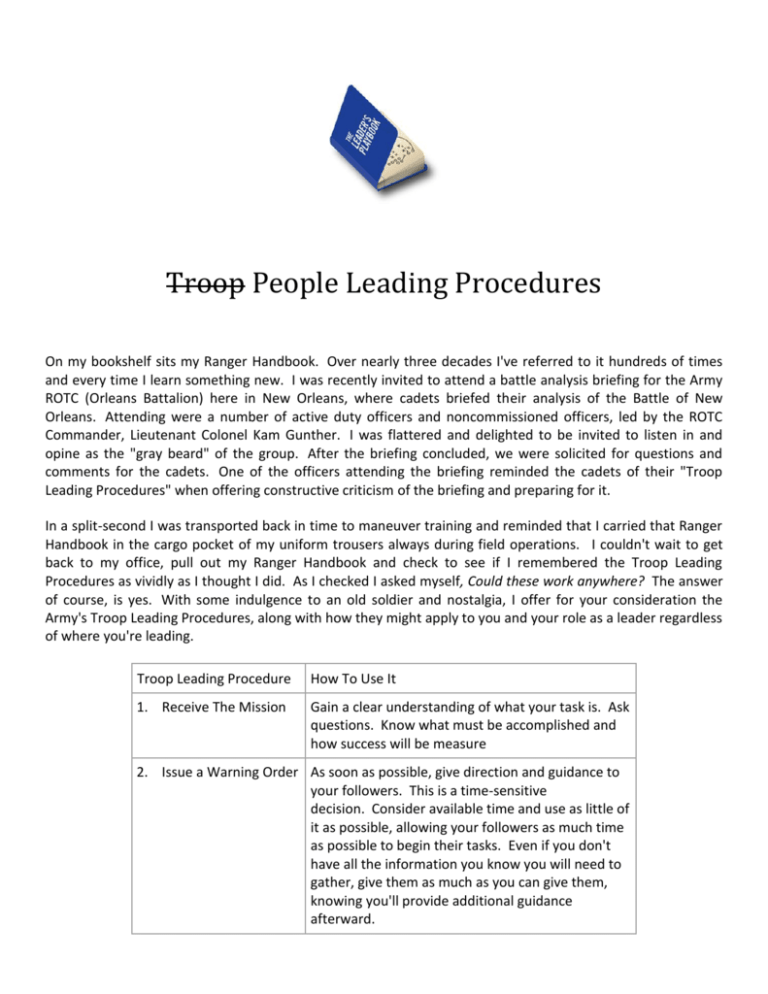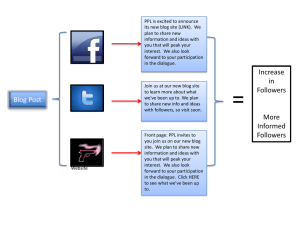Troop People Leading Procedures
advertisement

Troop People Leading Procedures On my bookshelf sits my Ranger Handbook. Over nearly three decades I've referred to it hundreds of times and every time I learn something new. I was recently invited to attend a battle analysis briefing for the Army ROTC (Orleans Battalion) here in New Orleans, where cadets briefed their analysis of the Battle of New Orleans. Attending were a number of active duty officers and noncommissioned officers, led by the ROTC Commander, Lieutenant Colonel Kam Gunther. I was flattered and delighted to be invited to listen in and opine as the "gray beard" of the group. After the briefing concluded, we were solicited for questions and comments for the cadets. One of the officers attending the briefing reminded the cadets of their "Troop Leading Procedures" when offering constructive criticism of the briefing and preparing for it. In a split-second I was transported back in time to maneuver training and reminded that I carried that Ranger Handbook in the cargo pocket of my uniform trousers always during field operations. I couldn't wait to get back to my office, pull out my Ranger Handbook and check to see if I remembered the Troop Leading Procedures as vividly as I thought I did. As I checked I asked myself, Could these work anywhere? The answer of course, is yes. With some indulgence to an old soldier and nostalgia, I offer for your consideration the Army's Troop Leading Procedures, along with how they might apply to you and your role as a leader regardless of where you're leading. Troop Leading Procedure How To Use It 1. Receive The Mission Gain a clear understanding of what your task is. Ask questions. Know what must be accomplished and how success will be measure 2. Issue a Warning Order As soon as possible, give direction and guidance to your followers. This is a time-sensitive decision. Consider available time and use as little of it as possible, allowing your followers as much time as possible to begin their tasks. Even if you don't have all the information you know you will need to gather, give them as much as you can give them, knowing you'll provide additional guidance afterward. 3. Make a Tentative Plan While actions are begun, do a more careful analysis of the task you're expected to accomplish. Develop a number of courses of action you can take. For example, will you choose to succeed to build-in several decision points, or proceed from beginning to end with no stops in between? 4. Initiate Movement Lead from the front where you have to. Teach, guide, and coach. Make corrections to any incorrect directions you may have given previously. 5. Conduct Reconnaissance Once satisfied that actions are proceeding satisfactorily, use this step to look ahead, anticipate what unexpected, or potential barriers might be "around the bend," and take appropriate actions to correct them before they get your followers bogged down. 6. Complete the Plan Once you're aware of what's ahead as your followers continue to work on the task, make any necessary adjustments, and give directions to your followers. 7. Issue The Order Check to make sure everyone understands. Clarify and eliminate uncertainty. Give directions to your followers. 8. Supervise Guide, teach, coach. Let your followers execute when they know how, teach them when they don't. Ensure the task is completed. Celebrate success when the task is accomplished!







